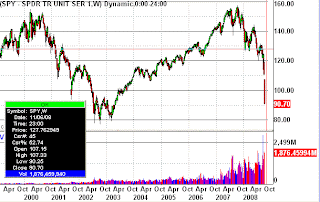I see a couple of scenarios playing out here which are combinations of some simple random variables.
List of Var's
+Market's Move In Between VotesPossible Outcomes:
- We rip up into the new vote
- We trade sideways into new vote
- We die into new vote
*Note Vix has hovered ~40 in last three days, hence the expectation of volatility.
+House Re-vote on Bailout
Possible Outcomes:
-Passage
-Failure
sub outcomes of Failure:
=>Eventual Passage
=>Bouncing Back and Forth
+Market Response to ANY US Legislature Event (vote, significant comments, etc)Possible Outcomes:
-Knee Jerk Up
-Knee Jerk Down
Secondary Outcomes (endemic to knee jerk event reactions):
-Reversal of reaction
-Continuation or maintenance of reaction
-Scenario 1: Rip Into New Vote + House Package Passes => Knee Jerk Up + 50% Reversal
-Scenario 2: Rip Into New Vote + House Package Doesn't Pass => Knee Jerk Down + Continuation
+Sub Scenario 2a: Bailout Eventually Passes: Bottoming or Crashing into Passing Vote => final bottom and upward after
+
Sub Scenario 2b: Bailout Bounces: Severe market decline, fed printing money, lowering rates doing everything it can to avoid depression
-Scenario 3: Sideways into New Vote + House Package Passes => Knee Jerk Up + Continuation
-Scenario 4: Sideways into New Vote + House Package Doesn't Pass => Knee Jerk Down + Continuation
+Sub Scenario 4a: Bailout Eventually Passes: Bottoming or Crashing into Passing Vote => final bottom and upward after
+
Sub Scenario 4b: Bailout Bounces: Severe market decline, closed markets, fed printing money, loweringrates doing everything it can to avoid depression
-Scenario 5: Crash Into Vote + House Package Passes => Knee Jerk Up + Monster Continuation
-Scenario 6: Crash Into Vote + + House Package Doesn't Pass => End of Time, Interest rates cut to zero






















